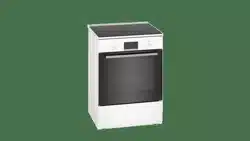Loading ...
Loading ...
Loading ...

en Preventing material damage
6
Leaving the appliance to cool down with the door open
will damage the front of neighbouring kitchen units over
time.
▶ Always allow the cooking compartment to cool
down with the door closed after cooking at high
temperatures.
▶ Take care not to trap anything in the appliance
door.
▶ Only leave the cooking compartment to dry with the
door open if a lot of moisture was produced during
operation.
Fruit juice dripping from the baking tray leaves stains
that cannot be removed.
▶ When baking very juicy fruit flans, do not pack too
much on the baking tray.
▶ If possible, use the deeper universal pan.
Using oven cleaner in a hot cooking compartment
damages the enamel.
▶ Never use oven cleaner in the cooking compartment
when it is still warm.
▶ Remove all food remnants from the cooking com-
partment and the appliance door before you next
heat up the appliance.
If the seal is very dirty, the appliance door will no
longer close properly during operation. This may dam-
age the front of adjacent kitchen units.
▶ Keep the seal clean at all times.
▶ Never operate the appliance if the seal is damaged
or missing.
Sitting or placing objects on the appliance door may
damage it.
▶ Do not place or hang objects on the appliance door.
▶ Do not place cookware or accessories on the appli-
ance door.
If you carry or move the appliance by the handle on the
cover or move, the handle may break off and cause
damage to the hinges. The handle of the cover is not
designed for the weight of the appliance.
▶ Do not carry or move the appliance by the handle
on the cover.
When grilling, due to high temperatures, the baking tray
or universal pan may become deformed and damage
the enamel coating when they are removed.
▶ When grilling, do not insert the baking tray or univer-
sal pan higher than level 3.
▶ Above shelf position 3, only grill directly on the wire
insert.
2.2 Hob
Follow the corresponding instructions when using the appliance.
Avoiding material damage
This is where you can find the most common causes of damage and tips on how to avoid them.
Damage Cause Measure
Stains Unsupervised cooking process. Monitor the cooking process.
Stains, blisters Spilled food, especially food with a high
sugar content.
Remove immediately with a glass scraper.
Stains, blisters or
fractures in the glass
Defective cookware, cookware with melted
enamel or cookware with copper or alu-
minium base.
Use suitable cookware that is in a good con-
dition.
Stains, discolouration Unsuitable cleaning methods. Only use cleaning agents that are suitable for
glass ceramic, and only clean the hob when
it is cold.
Blisters or fractures in
the glass
Knocks or falling cookware, cooking ac-
cessories or other hard or pointed objects.
When cooking, do not hit the glass or let ob-
jects fall onto the hob.
Scratches, discolour-
ation
Rough cookware bases or moving the cook-
ware on the hob.
Check the cookware. Lift the cookware when
moving it.
Scratches Salt, sugar or sand. Do not use the hob as a work surface or
storage space.
Damage to the appli-
ance
Cooking with frozen cookware. Never use frozen cookware.
Damage to the cook-
ware or the appliance
Cooking without contents. Never place or heat empty cookware on a
hot cooking zone.
Glass damage Melted material on the hot cooking zone or
hot pot lid on the glass.
Do not place greaseproof paper or alu-
minium foil nor plastic containers or pot lids
on the hob.
Overheating Hot cookware on the control panel or on the
frame.
Never place hot cookware on these areas.
Loading ...
Loading ...
Loading ...
